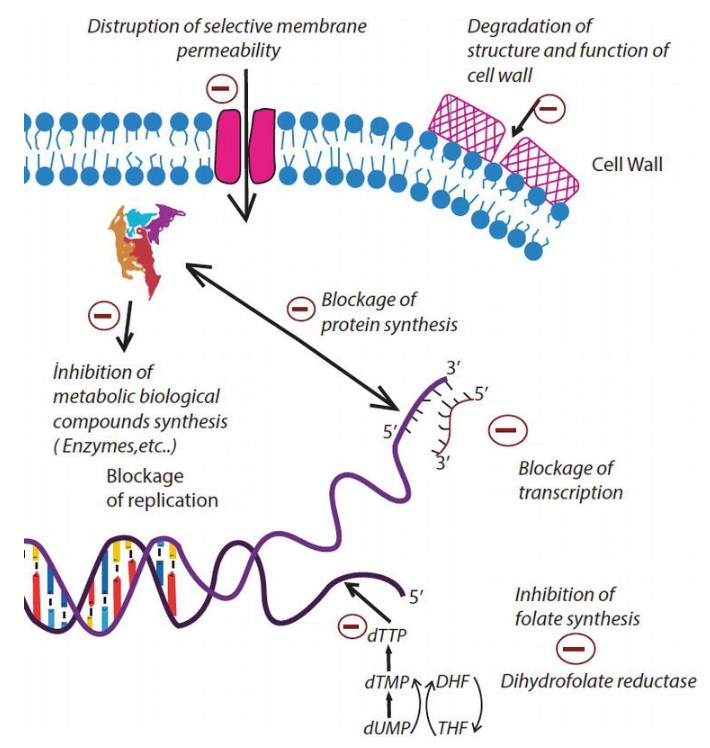Mode of Action & Target for Antibacterial Drug
With extensive and successful experience in antibacterial drug development, Creative Biolabs can manage your drug development program including project design, implementation, and results analysis. Our mission is to be a responsible and reliable drug discovery contract research partner throughout your entire project.
Mode of Actions and Targets for Antibacterial Drugs
The treatment of bacterial infections is increasingly complicated by the ability of bacteria to develop resistance to antimicrobial agents. Antimicrobial agents used for the treatment of bacterial infections are often categorized according to their principal mechanism of action. There are six major modes of action: (1) interference with cell wall synthesis, (2) inhibition of protein synthesis, (3) interference with nucleic acid synthesis, (4) inhibition of a metabolic pathway, (5) inhibition of membrane function, (6) inhibition of ATP Synthase (Fig.1). Therefore, according to its mechanism of action, the targets of antibacterial drugs include cell membrane, cell wall, protein synthesis, nucleic acid synthesis, and biological metabolic compound synthesis.
 Fig.1 Targets of antimicrobials.1
Fig.1 Targets of antimicrobials.1
Our Services for Antibacterial Drugs
Due to the increased resistance of microorganisms to traditional antibiotics, new drugs for microbial infections are urgently needed. To fully assist drug discovery and development, Creative Biolabs provides comprehensive, end-to-end clinical development and laboratory services with a full range of solutions. We are committed to helping our customers optimize their development plans and minimize R&D costs and time. Our services cover the six main modes of action of antimicrobials and support target and phenotypic discovery, including:
Inhibitors of Cell Wall Biosynthesis
Bacterial cells are surrounded by cell walls made of peptidoglycan. Peptidoglycan biosynthesis is essential to the integrity of the cell wall structure, and it is the outermost layer and the main component of the cell wall. Specific antibiotics interfere with the biosynthesis of peptidoglycans, thereby destroying the integrity of the cell wall. Since mammalian cells do not have the peptidoglycan wall structure, inhibition of cell wall peptidoglycan biosynthesis is a preferred target for the discovery of antibacterial agents, and at the same time has no significant negative impact on mammalian host cells.
Inhibitors of Protein Biosynthesis
Protein synthesis is a complex, multi-step process involving many enzymes and conformational alignment. However, most antibiotics interfere with the 30S or 50S subunits of the 70S bacterial ribosome to block bacterial protein synthesis. For example, tetracyclines, including doxycycline, prevent the binding of aminoacyl-tRNA by blocking the A (aminoacyl) site of the 30S ribosome. They are capable of inhibiting protein synthesis in both 70S and 80S (eukaryotic) ribosomes.
Inhibitors of Membrane Function
The bacterial membrane provides selective permeability for cellular homeostasis and metabolic energy-transduction. Several antimicrobial agents interfere with multiple targets through the interaction of a lipophilic moiety with the bacterial membrane, leading to the destruction of membrane structures and functional impairment. At present, antibacterial agents directed against the cytoplasmic membrane components of bacteria have been reported, and they can act on both Gram-negative and Gram-positive bacteria.
Inhibitors of Nucleic Acid Synthesis
Antibiotics can inhibit replication, transcription, and folate synthesis of microorganisms. Quinolone drugs can interfere with DNA synthesis by inhibiting topoisomerase, an enzyme involved in DNA replication. For example, the second-generation quinolone drugs levofloxacin, norfloxacin, and ciprofloxacin are active against both Gram-negative and Gram-positive bacteria. There are also antibiotics that interfere with RNA synthesis by inhibiting RNA polymerases, such as doxorubicin. They interfere with bacterial and mammalian systems and are therefore most commonly used as antineoplastic and antitumor drugs, attacking rapidly growing malignant cells as well as normal cells.
Inhibitors of Metabolic Pathways
Bacterial metabolism inhibitors are a class of antibiotics that target nucleic acid and amino acid synthesis pathways. Tetrahydro-folic Acid (TH4) is a key coenzyme used to synthesize nucleic acids and certain amino acids in all life forms. Bacteria synthesize their folic acid from the precursor para-aminobenzoic acid (PABA). Bacterial metabolism inhibitors affect bacterial metabolic pathways by interfering with the bacterial TH4 synthesis.
Inhibitor of ATP Synthase
ATP synthase is the principal energy-generating enzyme in all organisms from bacteria to vertebrates through oxidative phosphorylation or photophosphorylation. Bacteria can produce ATP through substrate-level phosphorylation of fermentable carbon sources or oxidative phosphorylation using respiratory chains and ATP synthase. Some antibiotics have been found to inhibit oxidative phosphorylation of ATP synthase to affect the energy production of bacteria, which in turn kills bacteria.
Creative Biolabs has decades of experience serving a large number of clients through hundreds of antimicrobial drug development projects. Our professional R & D team is committed to providing you with the best services and solutions to accelerate your antibacterial drug discovery. If what you are looking for is not on the list, please contact us or email us. We will gladly meet your drug discovery needs.
Reference
- Kırmusaoğlu, Sahra, ed. Antimicrobials, antibiotic resistance, antibiofilm strategies and activity methods. BoD–Books on Demand, 2019. Distributed under Open Access license CC BY 4.0, without modification.
For Research Use Only.
